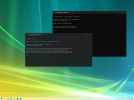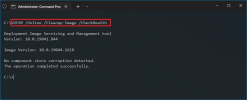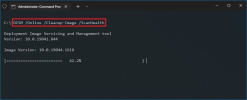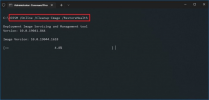Hotrod369
VIP
- Joined
- May 31, 2021
- Messages
- 387
If Windows 10 has missing or corrupted files, this guide will show you how to repair the setup using the DISM and SFC command tools.

Windows 10 DISM and SFC repair (Image credit: Windows Central)
On Windows 10, the Deployment Image Servicing and Management is a command-line tool that allows administrators to prepare, modify, and repair system images, including Windows Recovery Environment, Windows Setup, and Windows PE (WinPE). However, you can also use it with the local recovery image to fix system problems.
Typically, when you need to troubleshoot a specific error, figure out why the computer no longer boots correctly, or resolve performance issues, you can use the System File Checker tool to replace missing or corrupted system files using the recovery image. The caveat utilizing this approach is that if one or more Windows 10 files in the local image are damaged, the SFC command won't work. In this scenario, you can use the "install.wim" image with DISM to repair the image and then use the SFC tool to fix the setup without having to reinstall Windows.
In this Windows 10 guide, we will walk you through the steps to use the DISM and SFC tools to bring a computer back to a healthy working state without the need for reinstallation.
Warning: The commands outlined in this guide are non-destructive, but since you will be making system changes, it is still recommended to create a temporary full backup before proceeding.
To check the Windows 10 image for issues with DISM, use these steps:

Source: Windows Central (Image credit: Source: Windows Central)
Once you complete the steps, the Deployment Image Servicing and Management tool will run and verify any data corruption that may require fixing.
To check image problems with the ScanHealth option, use these steps:

Source: Windows Central (Image credit: Source: Windows Central)
After you complete the steps, the scan may take several minutes to check whether the Windows 10 image needs repairing.
To repair Windows 10 image problems with the DISM command tool, use these steps:

Source: Windows Central (Image credit: Source: Windows Central)
Once you complete the steps, the tool will connect to Windows Update online to download and replace damaged files (as necessary).
Download Windows 10 ISO file
If you need to use another file source, it is recommended to use the Media Creation Tool to download a fresh copy of Windows 10.
To download the ISO file of Windows 10, use these steps:

Source: Windows Central (Image credit: Source: Windows Central)

Source: Windows Central (Image credit: Source: Windows Central)

Source: Windows Central (Image credit: Source: Windows Central)

Source: Windows Central (Image credit: Source: Windows Central)

Source: Windows Central (Image credit: Source: Windows Central)
After you complete the steps, you can continue with the DISM tool using the "Source" option to repair the local image.
Fix Windows 10 recovery image
To run Deployment Image Servicing and Management tool with an alternate source (install.wim) image, use these steps:

Source: Windows Central (Image credit: Source: Windows Central)
Fix problems with DISM using ESD image
If you have an encrypted "install.esd" image, it's possible to use it to repair the damaged files on Windows 10.
To use DISM with an "install.esd" image file as the source to repair Windows 10, use these steps:

Source: Windows Central (Image credit: Source: Windows Central)
To use the SFC command tool to repair Windows 10 problems, use these steps:

Source: Windows Central (Image credit: Source: Windows Central)
Once you complete the steps, the System File Checker tool will repair the system files using the local image files, and the log files will be saved on
%windir%/Logs/CBS/CBS.log
and
%windir%\Logs\DISM\dism.log
, which you can view to get more details about the process.
You can use this guide to learn more ways to use the SFC tool to fix problems on Windows 10.

Windows 10 DISM and SFC repair (Image credit: Windows Central)
On Windows 10, the Deployment Image Servicing and Management is a command-line tool that allows administrators to prepare, modify, and repair system images, including Windows Recovery Environment, Windows Setup, and Windows PE (WinPE). However, you can also use it with the local recovery image to fix system problems.
Typically, when you need to troubleshoot a specific error, figure out why the computer no longer boots correctly, or resolve performance issues, you can use the System File Checker tool to replace missing or corrupted system files using the recovery image. The caveat utilizing this approach is that if one or more Windows 10 files in the local image are damaged, the SFC command won't work. In this scenario, you can use the "install.wim" image with DISM to repair the image and then use the SFC tool to fix the setup without having to reinstall Windows.
In this Windows 10 guide, we will walk you through the steps to use the DISM and SFC tools to bring a computer back to a healthy working state without the need for reinstallation.
Warning: The commands outlined in this guide are non-destructive, but since you will be making system changes, it is still recommended to create a temporary full backup before proceeding.
How to use DISM to repair image of Windows 10
On Windows 10, the DISM command tool includes three options to repair an image, including "CheckHealth," "ScanHealth," and "RestoreHealth," which you want to use in order. Also, depending on the issue, you can use the "RestoreHealth" option to fix the locally available image using different source files.DISM command with CheckHealth option
The CheckHealth option with the DISM tool allows you to determine any corruptions inside the local Windows 10 image. However, the option does not perform any repairs.To check the Windows 10 image for issues with DISM, use these steps:
- Open Start.
- Search for Command Prompt, right-click the top result, and select the Run as administrator option.
- Type the following command to perform a quick check and press Enter
 ISM /Online /Cleanup-Image /CheckHealth
ISM /Online /Cleanup-Image /CheckHealth

Source: Windows Central (Image credit: Source: Windows Central)
Once you complete the steps, the Deployment Image Servicing and Management tool will run and verify any data corruption that may require fixing.
DISM command with ScanHealth option
The ScanHealth option does a more advanced scan to find out whether the image has any problems.To check image problems with the ScanHealth option, use these steps:
- Open Start.
- Search for Command Prompt, right-click the top result, and select the Run as administrator option.
- Type the following command to perform an advanced DISM scan and press Enter
 ISM /Online /Cleanup-Image /ScanHealth
ISM /Online /Cleanup-Image /ScanHealth

Source: Windows Central (Image credit: Source: Windows Central)
After you complete the steps, the scan may take several minutes to check whether the Windows 10 image needs repairing.
DISM command with RestoreHealth option
If there are problems with the system image, use DISM with the RestoreHealth option to automatically scan and repair common issues.To repair Windows 10 image problems with the DISM command tool, use these steps:
- Open Start.
- Search for Command Prompt, right-click the top result, and select the Run as administrator option.
- Type the following command to repair the Windows 10 image and press Enter
 ISM /Online /Cleanup-Image /RestoreHealthQuick note: If the command appears stuck, this is normal behavior. After a few minutes, the process will complete successfully.
ISM /Online /Cleanup-Image /RestoreHealthQuick note: If the command appears stuck, this is normal behavior. After a few minutes, the process will complete successfully.

Source: Windows Central (Image credit: Source: Windows Central)
Once you complete the steps, the tool will connect to Windows Update online to download and replace damaged files (as necessary).
Fix problems with DISM using install.wim image
The Deployment Image Servicing and Management command usually doesn't cause issues. However, if the tool finds problems replacing the damaged files or the computer isn't connected to the internet, you will need to provide another image using the Source option. Typically, you can use an "install.wim" or "install.esd" file from another device, bootable install media, or Windows 10 ISO file. You only need to make sure that the files match the version, edition, and language of the version of Windows 10 you are trying to fix.Download Windows 10 ISO file
If you need to use another file source, it is recommended to use the Media Creation Tool to download a fresh copy of Windows 10.
To download the ISO file of Windows 10, use these steps:
- Open this Microsoft support website(opens in new tab).
- Click the Download tool now button.
- Double-click the MediaCreationToolxxxx.exe file to launch the setup.
- Click the Accept button to agree to the terms.
- Select the Create installation media (USB flash drive, DVD, or ISO file) for another PC option.

Source: Windows Central (Image credit: Source: Windows Central)
- Click the Next button.
- Click the Next button again.

Source: Windows Central (Image credit: Source: Windows Central)
- Select the ISO file option.

Source: Windows Central (Image credit: Source: Windows Central)
- Click the Next button.
- Select the destination to store the Windows 10 ISO file.
- Click the Save button.
- Click the link to open the file location with File Explorer.

Source: Windows Central (Image credit: Source: Windows Central)
- Click the Finish button.
- Double-click the Windows.iso file to mount the image.
- Under the "This PC" section, confirm the drive letter for the mount point.

Source: Windows Central (Image credit: Source: Windows Central)
After you complete the steps, you can continue with the DISM tool using the "Source" option to repair the local image.
Fix Windows 10 recovery image
To run Deployment Image Servicing and Management tool with an alternate source (install.wim) image, use these steps:
- Open Start.
- Search for Command Prompt, right-click the top result, and select the Run as administrator option.
- Type the following command to repair the Windows 10 image and press Enter
 ISM /Online /Cleanup-Image /RestoreHealth /Source:E:\Sources\install.wimIn the command, replace "F" with the ISO mount point drive letter in File Explorer.
ISM /Online /Cleanup-Image /RestoreHealth /Source:E:\Sources\install.wimIn the command, replace "F" with the ISO mount point drive letter in File Explorer.

Source: Windows Central (Image credit: Source: Windows Central)
- (Optional) Type the following command to limit the use of Windows Update and press Enter
 ISM /Online /Cleanup-Image /RestoreHealth /Source:E\Sources\install.wim /LimitAccess
ISM /Online /Cleanup-Image /RestoreHealth /Source:E\Sources\install.wim /LimitAccess - (Optional) Type the following variant of the previous command to accomplish the same task and press Enter
 ISM /Online /Cleanup-Image /RestoreHealth /Source:wim:E:\Sources\install.wim:1 /LimitAccessIn the command, change E:\Sources, for the path to the "install.wim" file.
ISM /Online /Cleanup-Image /RestoreHealth /Source:wim:E:\Sources\install.wim:1 /LimitAccessIn the command, change E:\Sources, for the path to the "install.wim" file.
Fix problems with DISM using ESD image
If you have an encrypted "install.esd" image, it's possible to use it to repair the damaged files on Windows 10.
To use DISM with an "install.esd" image file as the source to repair Windows 10, use these steps:
- Open Start.
- Search for Command Prompt, right-click the top result, and select the Run as administrator option.
- Type the following command to repair the image with an "install.esd" file and press Enter
 ISM /Online /Cleanup-Image /RestoreHealth /Source:C:\ESD\Windows\sources\install.esdIn the command, change C:\ESD\Windows\sources with the path to the location of the ".esd" file (if different).
ISM /Online /Cleanup-Image /RestoreHealth /Source:C:\ESD\Windows\sources\install.esdIn the command, change C:\ESD\Windows\sources with the path to the location of the ".esd" file (if different).

Source: Windows Central (Image credit: Source: Windows Central)
- (Optional) Type the following command to limit the use of Windows Update and press Enter
 ISM /Online /Cleanup-Image /RestoreHealth /Source:C:\ESD\Windows\sources\install.esd /LimitAccess
ISM /Online /Cleanup-Image /RestoreHealth /Source:C:\ESD\Windows\sources\install.esd /LimitAccess - (Optional) Type the following variant of the previous command to accomplish the same task and press Enter
 ISM /Online /Cleanup-Image /RestoreHealth /Source:esd:C:\ESD\Windows\sources\install.esd:1 /LimitAccess
ISM /Online /Cleanup-Image /RestoreHealth /Source:esd:C:\ESD\Windows\sources\install.esd:1 /LimitAccess - (Optional) Type the following command to use an install.esd file located in another drive and press Enter
 ISM /Online /Cleanup-Image /RestoreHealth /Source:E:\Sources\install.esdIn the command, replace E:\Sources with the path to the location of the "install.esd" file.
ISM /Online /Cleanup-Image /RestoreHealth /Source:E:\Sources\install.esdIn the command, replace E:\Sources with the path to the location of the "install.esd" file.
How to run SFC to repair problems on Windows 10
The above instructions will resolve problems with the system image, not the issues with the Windows 10 installation. After restoring the image to a healthy state, use the System File Checker (SFC) command tool to repair the current setup.To use the SFC command tool to repair Windows 10 problems, use these steps:
- Open Start.
- Search for Command Prompt, right-click the top result, and select the Run as administrator option.
- Type the following command to repair the installation and press Enter:SFC /scannowQuick tip: If errors are found, you may want to run the command around three times to ensure that everything was fixed correctly.

Source: Windows Central (Image credit: Source: Windows Central)
Once you complete the steps, the System File Checker tool will repair the system files using the local image files, and the log files will be saved on
%windir%/Logs/CBS/CBS.log
and
%windir%\Logs\DISM\dism.log
, which you can view to get more details about the process.
You can use this guide to learn more ways to use the SFC tool to fix problems on Windows 10.